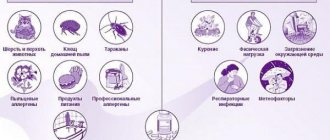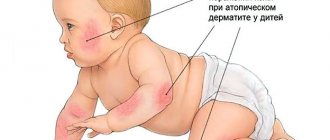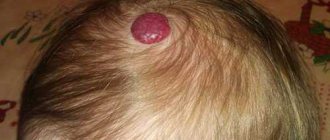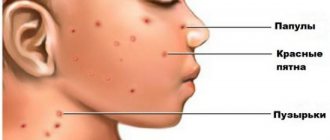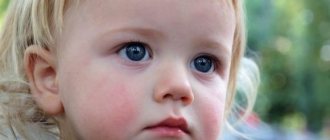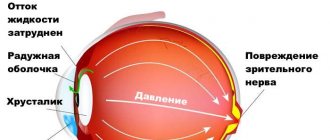Causes
Each child's body has individual characteristics. That is why the causes of red cheeks can be pathological and harmless. Only a specialist in this field can correctly differentiate them.
The first group includes the following diseases:
- Symptom of allergic dermatitis.
- A sharp increase in body temperature.
- An infectious disease begins to actively multiply in the body.
- Ring-shaped erythema.
- The newborn was previously diagnosed with lupus erythematosus.
- Improper functioning of the cardiovascular system.
A spot on the cheek may be completely safe. It must be treated or eliminated with medications if it appears under the influence of the following factors:
- Delicate skin has been irritated by saliva or food.
- A child's cheeks turn red if he has been in the sun for a long time. The baby should not be wrapped up, since overheating can also provoke this situation.
- The period of growth of the first teeth.
- Before the redness, the baby was actively moving for a long time.
- Symptoms may appear after walking outdoors. However, the weather was too cold and windy.
If your baby’s cheeks are also peeling, you should immediately consult a pediatrician. Additional symptoms may include general malaise or increased body temperature
Features of the manifestation of allergic dermatitis
The disease manifests itself in the form of redness on the cheeks due to consumption of food or contact with certain cosmetics. Some children are allergic to animal fur or medications. In this case, the nose and forehead may turn red.
Additionally, some babies experience peeling skin, itching and profuse rashes. Other symptoms include problems in the gastrointestinal tract, swelling of the mucous membrane, throat, and nose. An infant may also have tears and a runny nose.
Food allergies can develop while breastfeeding if the woman does not adhere to a special diet.
As preventive measures, the following foods should be removed from the diet:
- all types of nuts;
- mushrooms;
- fruits and vegetables of red (orange) color have a negative effect;
- citrus fruits and seafood;
- smoked sausages and meat;
- some types of fish and fatty meats.
A woman during lactation should carefully select her diet. New products are being introduced gradually.
If the baby develops a red rash, then this ingredient must be excluded from the diet for at least another month.
If the baby is bottle-fed, an allergy may occur directly to the formula itself. Quite often, the reaction appears against the background of intolerance to cow's milk. This component is often included in cereals and mixtures. A GV specialist will help you choose the optimal composition. It will not irritate the gastrointestinal tract or cause allergies. Today you can purchase a special hypoallergenic mixture. It is ideal for children with a tendency to this negative reaction.
Products that most often cause allergies
When adding to your baby's diet, you can often notice reddening of the cheeks. This is a reaction to a product that was previously unknown to the body. You can track your reaction using a food diary. In it, the woman must note the date and quantity of the new product she ate. If there is a negative reaction, it should be abandoned. You can try the dish next time only in a month.
Complementary foods must be administered correctly. A new product is tried no more than once every two weeks. If the baby’s skin is very red, then you should refuse it. Vegetables and fruits should only be seasonal and completely natural. Experts advise buying purees that are designed taking into account the characteristics of the child’s digestive system.
Red spots on the skin can be a result of long-term use of antibiotics. This drug for children is sold in the form of syrup. If redness appears, you should immediately consult your doctor. The situation can also arise against the background of long-term use of medications.
Baby skin care products should be hypoallergenic. A baby develops a rough body if soap and shampoo do not suit him. Wearing clothes made of synthetic fabric for a long time or washing them with low-quality powder can have a negative effect. If a child's cheeks or hands turn red, this indicates contact with an allergen.
Red cheeks as a symptom of illness
It is important for every parent to understand why red spots appear on their baby’s skin. The disease rarely goes away with only one symptom, so they must be extremely attentive to the appearance and behavior of the baby. The situation manifests itself in the evening if the baby has a cold or an infection is actively developing in his body. The disease can also be bacterial in nature.
Features of the manifestation of enzymatic deficiency
Some experts say that a baby's red cheeks are a consequence of overeating. The fact is that up to a year old, babies cannot yet independently control the saturation process. The situation is dangerous and can cause overeating, which negatively affects the functioning of the gastrointestinal tract. The digestive system is not mature, so it does not have enough enzymes. Against this background, the baby may experience redness in the evening. In this case, there is no point in looking for an allergen. All you have to do is start controlling your portions and avoid eating too much food.
Treatment for enzyme deficiency involves taking additional amounts of essential enzymes. After a certain time, the situation should normalize on its own.
With roseola, the child’s body temperature rises
Features of the manifestation of roseola in children
This disease is classified as infectious. It develops under the influence of the herpes virus (types 6 and 7). Most often, characteristic manifestations can be found in children aged four months to two years. Among other symptoms, a sharp increase in body temperature up to 40 degrees should be noted. The rash may appear on one side and then spread over the entire face. It tends to spread from top to bottom. Additionally, children experience an almost complete lack of appetite. For treatment, it is necessary to take antipyretic drugs and give the baby as much fluid as possible.
Features of the manifestation of skin eczema
The disease is serious and quite often develops into a chronic condition. The first symptoms appear in babies aged two months. The situation develops against the background of a hereditary predisposition.
Eczema may begin to appear on the cheeks and then spread to other areas of the human body. They turn red and begin to peel off. After a certain period, the situation gets worse regarding the appearance of cracks. They bleed or ooze fluid. Weeping spots cause a lot of discomfort to the baby, they itch and hurt. The task of parents is to properly care for their skin. In this case, secondary bacterial infection will be avoided.
Symptoms of pneumonia
The disease develops against the background of an infectious lesion of the lung tissue. In this case, the baby may experience redness on the cheeks and tip of the nose. Lips become pale. Additionally, the little patient’s body temperature increases, there is a lack of appetite, weakness and rapid breathing. To treat pneumonia in an infant, it is necessary to admit him to a hospital. The cheeks may turn red due to acetone syndrome and improper liver function.
Before a walk in the cold season, you need to apply baby cream to your cheeks.
Red cheeks and fever in a child
What is the phenomenon when a child's cheeks turn red? Many mothers think that blush suits the child, and there is no danger in this.
This is often true, but only if there are no additional symptoms of various diseases. To understand the question of whether such a sign as red cheeks in a child poses a danger to his health.
To do this, let us analyze in detail the various symptoms of this symptom.
Why does a child have red cheeks?
Having noticed the redness of a child’s cheeks, parents are more likely to begin to take action without understanding the cause. Most breastfeeding mothers believe that this is a reaction to some food eaten, and go on a strict diet.
If the baby eats formula, then they blame it and rather try to switch him to another dairy product. Others believe that the problem is in complementary feeding, and the baby is beginning to be limited in it. However, often the reason does not lie in nutrition at all.
We will look at why red cheeks are observed in a child and what to do about it in this article.
Diathesis
Pediatricians call redness of the cheeks the first sign of diathesis in an infant. This is not a disease, but a type of allergic reaction that occurs very often in childhood, even in newborns. There is no need to panic about this; it can be successfully treated at any age without much effort.
The cause of diathesis is most often the malnutrition of a nursing mother, the use of toxic substances (including some medications). Also, the child’s reaction is influenced by hereditary factors and environmental conditions.
In addition to red cheeks, diaper rash is observed in places where folds form (neck, knees, groin area, elbows), red rash, irregular bowel movements, irritation of the mucous membranes (conjunctivitis), dry yellow crusts on the head (seborrheic dermatitis). The surface of the tongue becomes uneven.
Overweight children are more susceptible to diathesis.
Treatment of diathesis consists of normalizing the diet of a nursing mother or switching to another formula, but an accurate diagnosis can only be established by a doctor.
Atopic dermatitis
It has some similarities with diathesis, but can be caused not only by food, but also by various other irritants: fabrics, cosmetics, animal hair, dust, medications and even some pathogens (bacteria, viruses, fungi).
One of the key signs of atopic dermatitis is a pronounced skin reaction: redness, the appearance of a capillary network, rashes, itching, dryness and flaking of the skin. Most often, these symptoms affect the facial area, so red cheeks may indicate this disease.
Source: https://dou99.ru/temperatura/krasnye-shheki-i-temperatura-u-rebenka
First aid
If redness occurs regularly, it is necessary to find the cause of this condition. Parents cannot do this on their own. This will require a full examination and diagnosis by a pediatrician. Only on the basis of the obtained tests will it be possible to choose the correct course of treatment. If redness on the cheeks appears due to an allergic reaction, then to eliminate it you must follow the following rules:
- Avoid direct contact with the allergen.
- Mommy must stick to a diet. If the baby eats formula, then a breastfeeding specialist will be able to select it correctly.
- Enterosorbents will help remove harmful components from the body.
- If necessary, your doctor may prescribe antihistamines.
- To treat areas with inflammation, it is necessary to use creams and ointments that help eliminate inflammation and itching.
Herbal lotions help get rid of itching quickly and effectively. For this purpose, you can use chamomile, string, oak bark or plantain. Thanks to them, it will be possible to minimize the likelihood of scratching and, as a result, infection.
Since childhood, we have been steadily following the stereotype: red cheeks indicate healthy blood circulation. However, this statement is only part of the truth. A red complexion can warn of a serious illness. The child's immune system is vulnerable. Every day your child faces the risk of getting sick. And you should watch for the slightest signs of illness. The health of the blood depends on your observation. Learn to distinguish a light blush from painful redness.
Safe Reasons
- Freezing
When you return home after a walk, you may notice a pinkish blush on your cheeks. The reason for this is the temperature difference. Rest assured, the redness will go away within an hour.
- Active games
Children love to explore the world through play. At the same time, blood rushes to the head, and for this reason the face turns red. If your child has been playing around recently, let him calm down. Normal complexion will quickly return.
- Overheat
Why does a child have red cheeks in summer? In the open sun, children quickly overheat. Noticed this symptom while walking? Urgently take the child to the shade and give him water. Also, your baby may overheat if you put too many clothes on him in winter. Skim off excess and add water.
Children do not know how to hide their anger and shame. And this may be a useful signal for you. Calm the child down and talk to him. Find out why he felt this emotion. In the long term, this will help you build friendly relationships.
- Irritation after eating
Children under two years old have sensitive skin, and they eat sloppily. Food on the face may cause mild irritation. There's no need to worry. Wash your child’s face, and soon everything will pass.
- Pets
If you have a dog, it may lick your child's face. The saliva of some animals can cause a mild allergic reaction on delicate skin. Proceed in the same way as with food.
- The house is dry and hot
Usually during the day the cheeks are of normal color, but in the evening they turn red. In this case, install a humidifier and ventilate the room regularly. To relieve your child of redness today, take a bath with him and give him more water.
- Unfamiliar skin conditions
The red cheeks of babies may peel as soon as they are born. There is nothing to be afraid of. This will not cause discomfort to the baby. He just needs to get used to life in liquid and get used to air.
Dangerous reasons
In the previous subsection, we looked at slight redness of the skin after a walk. However, if you delay returning home, your child’s cheeks will get frostbite. The first sign of frostbite is white spots on red cheeks. If you notice him, return home immediately. You can protect your child from frostbite with fatty creams. Walk for a strictly allotted time and watch the cold. Maybe you shouldn't go for a walk today?
- Teeth coming through
This process in itself is not dangerous, but teething is the cause of increased temperature. Infants and older children are harmed by any deviations from normal temperature.
When a child is teething, he is capricious, asks to be held and does not want to eat. At the same time, the cheeks, skin around the nose and mouth turn red.
To relieve inflammation, let your child chew on a cool teaspoon or a special cooling rattle. The unpleasant sensations will disappear. Distract your child with play and he will feel better. As soon as the tooth comes out, the redness will go away.
- Diathesis
Diathesis is the cause of bright red spots on the cheeks. They don't disappear over time. Depending on the type, the rash can be dry, wet or mixed.
Diathesis warns of diseases to which the baby is predisposed. Usually he talks about allergies.
In infants, diathesis can occur from cow's milk and red fruit purees. He will have a stomach ache, frequent diarrhea, and greenish-colored feces.
Older children may develop diathesis
due to red fruits, citrus fruits and cereals. Diarrhea, sore throat and cough are common symptoms of such diathesis.
Children from three years of age often get diathesis from sweets, nuts, crayfish and seasonings. If you feed your child pickles, try eliminating them. Diathesis at this age is no longer so dangerous. And the only symptom is red rashes.
If you notice a sign of diathesis, urgently take your child to the pediatrician. Without urgent treatment, diathesis can turn into real allergies or chronic skin diseases.
- Allergy to food
Do not confuse diathesis with allergies. Diathesis is a warning about the possible appearance of a disease. An allergy is a full-fledged protective reaction of the body to an allergen. If in the case of diathesis the reaction can be cured, then allergies are a chronic disease.
Twenty percent of children worldwide suffer from allergies. The most “popular” type of allergy is to certain foods. Food allergies are dangerous because they can change. Its strength depends on the time and type of preparation of the product. For example, a child may have a severe allergy to fresh carrots, but will tolerate them when cooked.
The main sign of an allergy is a rash
. It may look different. Spots and blisters are just some of the possible skin reactions. However, red cheeks are the first reason to be wary.
Take a closer look at your child. Is he scratching his red cheeks? The allergy causes severe itching that children cannot ignore. In the evening and at night it intensifies, and even in sleep the child may itch.
Along with redness and itching, digestion
. The child may complain of abdominal pain. He often feels nauseous and diarrhea. Swelling of any parts of the face and body is common.
- Eczema
One in three children gets eczema. It develops between the ages of three and six months.
Eczema looks like a red, dry crust with cracks. Blood or clear liquid often oozes from the cracks. This disease occurs in folds of skin throughout the body. So if you notice peeling cheeks in a child who is not showing other signs of illness, check the wrists, elbows and other joints.
Eczema is dangerous because it undermines the protective
mechanism of the skin. Skin with eczema no longer saves the body from infection, but conducts it. Eczema is very itchy, so the baby will constantly pick at it. So it widens the cracks, the skin peels and bleeds.
The child inherits eczema from his parents. There is no cure, but you can control the symptoms with medication. Urgently contact a dermatologist so that he can prescribe a course of treatment. Take good care of your baby's skin, and soon the symptoms will subside.
Infectious disease in children from four months to two years.
With roseola, the temperature rises sharply to 38–39 degrees. You may be wondering why there is no cough or other cold symptoms. The baby will be capricious and refuse to eat. This is a serious reason to think about roseola.
The temperature will last 2–5 days. When it subsides, a pink rash will begin to spread across the body, starting from the face. The rash turns white when touched, but unlike eczema, it does not peel off. The temperature will not rise again, but the child will still feel unwell.
Cheeks may turn red when a tick has embedded itself in the skin. First, red dots appear on the skin. Over time, they turn into bright spots. Areas of redness may look like pimples, and the child will scratch them.
Take your child to a dermatologist immediately. Delay can cost your health.
- Pneumonia
With pneumonia, the cheeks turn red, and the nose and lips turn pale. Along with this, the child will be lethargic and will not want to eat. Over time, his temperature will rise. As soon as you notice these signs, immediately show your child to the doctor.
- Diseases of the heart and blood vessels
Babies with heart defects or high blood pressure look great during the day. However, in the evening the cheeks begin to turn red and reach their peak in sleep. Get examined by a cardiologist.
The child's cheeks turn red after eating
I’ve been meaning to write for a long time about how we met this badass. A year ago I didn’t know anything about this, I read stories of other mothers on the Internet, now I hope mine will be useful to someone. My daughter was 1 year 11 months old when 2 pink spots appeared under her knees. They didn’t itch, and at times they turned pale. This was in November, in December we turned 2, and after the holidays they turned into terrible crusts and grew larger. When we came to the KVD, the dermatologist's eyes bulged: what are you, mother, you have an allergic child - a strict diet: porridge with water (buckwheat, rice, oatmeal), steamed vegetables (zucchini, cabbage, potatoes), dried bread, gray bread, kefir. Hydrocartisone ointment. Get tested for dysbacteriosis, I don’t know where, ask your pediatrician. That's all the treatment! An appointment with an allergist in the regiment - on Thursdays at 12:00 you call - it’s busy, then the appointment is completed. While we were recording, 3 weeks had passed. My feet were terrible - my claws stuck to the sores. Having gathered all sorts of advice, we run tests: blood for parasites, for Igm, feces for dysbacteriosis = 6 thousand rubles. We come to the allergist with everything we have collected, they praise mom, they look at her feet: wow, what a good dermatitis you have! In tests for parasites - the presence of mysterious Giardia, in tests for dysbacteriosis - bifido lacto is reduced, coli which I don’t remember is overestimated. Img increased. I have a nightmare in my head! The allergist offers a bunch of things: we treat Giardia, drink bacteria, cleanse ourselves with enterosorbents, apply creams. To our modest diet we added lean beef, cottage cheese, and corn porridge. I agree to everything and run to the pharmacy to save the child. We apply allergens. Having examined our, by that time, weeping sores, the doctor makes a diagnosis of atopic dermatitis, complicated by infection. In general, all this time, we treated everything except what was needed, lamblia, dysbacteriosis, and took antihistamines. But they didn’t know how to relieve the exacerbation of dermatitis. We’re talking about nutrition, I ask: we eat poorly, we respect kefir, we drink a liter, is this normal? Answer: what are you doing? You can’t have that much protein, max 200 grams, but it’s better to remove the milk completely. Treatment: xysal, bluing on the lesions, take a skin culture for flora and sensitivity to antibiotics. If staphylococcus is detected - additional treatment (Triderm, Protopic) + skin softening Bübchen, Sanosan, bathe Emolium. I called the laboratory to do a culture from the wounds for a bacterial infection - the answer is that you don’t have enough discharge, you need it, it’s festering. One of them actually told me that you can’t be treated with antibiotics for dermatitis!!! Wow! Like move on, scratch the infection! We go to the KVD to see a dermatologist. By then we have spots on our calves, thighs, wrists, and buttocks. The young girl sympathizes, looks, suggests a hospital (the main argument is summer, it’s hot, dusty, and you have open wounds). This analysis is also not done for suspected staphylococcus infection. I am happy because... I have long hoped that an allergist would suggest it to us, we would go to the regional clinic and they would help us. But we are sent to the regional skin clinic. With a lump in my throat, I take the direction, pack my things, and go. We arrive at 10:00 am as requested, sit in line for a preliminary consultation, scratch our legs until they bleed, show the doctor - lie down without any options. While all the formalities have passed, it’s 13:00 and the hungry child is whining (they also canceled kefir). They brought us to the ward: I was shocked: there was nothing for the children, no beds, no potties. With me in the room is a mother with a boy, and an aunt with a red face. There is no attending physician, we were examined by a young girl intern, they prescribed dermatol ointment and bluing, the newborn is bandaged - my daughter is a mummy. The contingent of our department: boys with lichen, and grandmothers with terrible sores, who sleep during the day and ask the children not to make noise and not to run. Another “pleasant” surprise: there are no children’s or diet tables. For lunch my daughter ate rassolnik and for dinner fish and zucchini. Great start to treatment. By the evening, it dawns on me that it’s hot as hell in the ward, it’s +30 outside, in the ward it’s probably all +35. The windows do not open, only 1 window 20 cm kV. The only joy is a portable DVD with cartoons. I was given diphenhydramine for the night. The roommate closes the window to “let it blow out.” A sleepless, sweaty night of tears awaited us! My daughter fell asleep while I was scratching her. The next day a doctor came - a lady of the old Soviet school. She said that our tests were nonsense. What do you think, why do you have this? Oh, I forgot to say that before going to bed, we also visited a gastroenterologist (Creon, Chofitol, Normbakt). So you are treated as it is written here. I ask, maybe we can switch to day time, take pills, come and get smeared and bandaged. Otherwise, we sleep poorly - it’s hot, and there are problems with nutrition. Answer: you will soon be alone in the ward, the rest will be discharged. And don’t come to me with such questions, if you don’t like it, get outpatient treatment at your place! I went and cried, packed my things, wrote a refusal statement, took a prescription for dermatol ointment and we left. By the way, as soon as we got into the car with air conditioning, my daughter fell asleep and slept for the entire 4 hours of the way back. Part 3. We arrived home and washed ourselves! Although it was banned in tanning. We smeared ourselves and bandaged ourselves. On the 3rd day without kefir, + Creon (enzymes), my daughter gained an appetite! For 2 weeks we applied dermatol ointment and walked around in bandages. We went to a paid allergist, they did a throat swab, and they found staphylococcus. We drank a suitable antibiotic, applied Triderm, Protopic. We monitored our diet. Take care of your skin. October: Atopic dermatitis, subacute course, complicated by staphyloderma. We are still following all the doctor’s recommendations. My daughter looks very good, sometimes a couple of spots get worse or her cheeks turn red, it’s my fault, we deviate from the rules. CONCLUSIONS: Atopic dermatitis can be triggered at any age. First signs: red cheeks, rash, dry skin, itching. First of all, identify the provocateur and exclude it. Organize your daily life: remove woolen clothes (irritates the skin), all dust collectors (carpets, old books, soft toys), animals are a separate issue, we have a cat who lived before the birth of the child, but now she is often washed, combed, and does not sleep on bed. Everyone adjusts their diet based on their reactions (we exclude: all dairy, fish, eggs, citrus fruits, cocoa, canned food, red fruits and vegetables, limited sweets). Do not overfeed your child - thin and hungry people do not have allergies. If he doesn’t want to eat, don’t persuade him, don’t force him; food eaten without appetite is poorly digested and provokes dysbacteriosis and allergic reactions. And there is nothing wrong with the fact that the child does not eat some foods; calcium, for example, is better absorbed from cereals and vegetables; the Internet is full of signs about the amount of calcium in non-dairy products. Atopic skin care. Moisturize several times a day, whatever you like: Bübchen milk (not oil), Sanosan; There are more expensive bioderma atoderm, avene, there are whole series for dry sensitive skin, restore the lipid layer, etc., creams and bath products. Mustella stellotopia - for children with dry, irritated skin. We smear the whole child, we don’t skimp. Swim every day, but not for long, 15-20 minutes. Water is no more than 37 degrees, preferably 35. In general, avoid overheating, steaming, and sweating. It’s not enough to just relieve inflammation with miracle creams; atopics always need to nourish and moisturize the skin! At home the temperature is 20 degrees, less is better, the air is humid. It’s always with us: they came to visit - it’s hot, they played on the old carpet, they treated us to sweets - in the evening, cheeks like Parsley’s. In winter, pay attention to mittens and hats - without wool. In summer, all clothes are cotton. It’s better to let the child be cool, the main thing is not hot. Instruct all your friends and grandmothers - There are always people who want to treat you to candy. Warn the pediatrician; there may be a reaction to vaccinations or medications. And remember, there are no miracle cures for blood pressure; if food reactions can change and weaken with age, then dry and sensitive skin is most likely for life. But you can find your advantages here too: the whole family began to eat healthier and healthier food, I already have a lot of Lenten recipes; a child does not spoil his teeth with sweets, and his gastrointestinal tract with chips and lollipops. Only one question remains open: it seems that it is quite difficult to graduate from medical school (my sister is in medical school), and they all teach them according to the same system and the same books, but they treat us I don't think these people are at all. Well, at least we meet them very rarely. And while we are looking for our savior in a white coat, we are wasting a lot of time, money and effort. I would like to meet smart, tactful and attentive doctors more often.
A year ago I didn’t know anything about this, I read stories of other mothers on the Internet, now I hope mine will be useful to someone. My daughter was 1 year 11 months old when 2 pink spots appeared under her knees. They didn’t itch, and at times they turned pale. This was in November, in December we turned 2, and after the holidays they turned into terrible crusts and grew larger. When we came to the KVD, the dermatologist's eyes bulged: what are you, mother, you have an allergic child - a strict diet: porridge with water (buckwheat, rice, oatmeal), steamed vegetables (zucchini, cabbage, potatoes), dried bread, gray bread, kefir. Hydrocartisone ointment. Get tested for dysbacteriosis, I don’t know where, ask your pediatrician. That's all the treatment! An appointment with an allergist in the regiment - on Thursdays at 12:00 you call - it’s busy, then the appointment is completed. While we were recording, 3 weeks had passed. My feet were terrible - my claws stuck to the sores. Having gathered all sorts of advice, we run tests: blood for parasites, for Igm, feces for dysbacteriosis = 6 thousand rubles. We come to the allergist with everything we have collected, they praise mom, they look at her feet: wow, what a good dermatitis you have! In tests for parasites - the presence of mysterious Giardia, in tests for dysbacteriosis - bifido lacto is reduced, coli which I don’t remember is overestimated. Img increased. I have a nightmare in my head! The allergist offers a bunch of things: we treat Giardia, drink bacteria, cleanse ourselves with enterosorbents, apply creams. To our modest diet we added lean beef, cottage cheese, and corn porridge. I agree to everything and run to the pharmacy to save the child. We apply allergens. Having examined our, by that time, weeping sores, the doctor makes a diagnosis of atopic dermatitis, complicated by infection. In general, all this time, we treated everything except what was needed, lamblia, dysbacteriosis, and took antihistamines. But they didn’t know how to relieve the exacerbation of dermatitis. We’re talking about nutrition, I ask: we eat poorly, we respect kefir, we drink a liter, is this normal? Answer: what are you doing? You can’t have that much protein, max 200 grams, but it’s better to remove the milk completely. Treatment: xysal, bluing on the lesions, take a skin culture for flora and sensitivity to antibiotics. If staphylococcus is detected - additional treatment (Triderm, Protopic) + skin softening Bübchen, Sanosan, bathe Emolium. I called the laboratory to do a culture from the wounds for a bacterial infection - the answer is that you don’t have enough discharge, you need it, it’s festering. One of them actually told me that you can’t be treated with antibiotics for dermatitis!!! Wow! Like move on, scratch the infection! We go to the KVD to see a dermatologist. By then we have spots on our calves, thighs, wrists, and buttocks. The young girl sympathizes, looks, suggests a hospital (the main argument is summer, it’s hot, dusty, and you have open wounds). This analysis is also not done for suspected staphylococcus infection. I am happy because... I have long hoped that an allergist would suggest it to us, we would go to the regional clinic and they would help us. But we are sent to the regional skin clinic. With a lump in my throat, I take the direction, pack my things, and go. We arrive at 10:00 am as requested, sit in line for a preliminary consultation, scratch our legs until they bleed, show the doctor - lie down without any options. While all the formalities have passed, it’s 13:00 and the hungry child is whining (they also canceled kefir). They brought us to the ward: I was shocked: there was nothing for the children, no beds, no potties. With me in the room is a mother with a boy, and an aunt with a red face. There is no attending physician, we were examined by a young girl intern, they prescribed dermatol ointment and bluing, the newborn is bandaged - my daughter is a mummy. The contingent of our department: boys with lichen, and grandmothers with terrible sores, who sleep during the day and ask the children not to make noise and not to run. Another “pleasant” surprise: there are no children’s or diet tables. For lunch my daughter ate rassolnik and for dinner fish and zucchini. Great start to treatment. By the evening, it dawns on me that it’s hot as hell in the ward, it’s +30 outside, in the ward it’s probably all +35. The windows do not open, only 1 window 20 cm kV. The only joy is a portable DVD with cartoons. I was given diphenhydramine for the night. The roommate closes the window to “let it blow out.” A sleepless, sweaty night of tears awaited us! My daughter fell asleep while I was scratching her. The next day a doctor came - a lady of the old Soviet school. She said that our tests were nonsense. What do you think, why do you have this? Oh, I forgot to say that before going to bed, we also visited a gastroenterologist (Creon, Chofitol, Normbakt). So you are treated as it is written here. I ask, maybe we can switch to day time, take pills, come and get smeared and bandaged. Otherwise, we sleep poorly - it’s hot, and there are problems with nutrition. Answer: you will soon be alone in the ward, the rest will be discharged. And don’t come to me with such questions, if you don’t like it, get outpatient treatment at your place! I went and cried, packed my things, wrote a refusal statement, took a prescription for dermatol ointment and we left. By the way, as soon as we got into the car with air conditioning, my daughter fell asleep and slept for the entire 4 hours of the way back. Part 3. We arrived home and washed ourselves! Although it was banned in tanning. We smeared ourselves and bandaged ourselves. On the 3rd day without kefir, + Creon (enzymes), my daughter gained an appetite! For 2 weeks we applied dermatol ointment and walked around in bandages. We went to a paid allergist, they did a throat swab, and they found staphylococcus. We drank a suitable antibiotic, applied Triderm, Protopic. We monitored our diet. Take care of your skin. October: Atopic dermatitis, subacute course, complicated by staphyloderma. We are still following all the doctor’s recommendations. My daughter looks very good, sometimes a couple of spots get worse or her cheeks turn red, it’s my fault, we deviate from the rules. CONCLUSIONS: Atopic dermatitis can be triggered at any age. First signs: red cheeks, rash, dry skin, itching. First of all, identify the provocateur and exclude it. Organize your daily life: remove woolen clothes (irritates the skin), all dust collectors (carpets, old books, soft toys), animals are a separate issue, we have a cat who lived before the birth of the child, but now she is often washed, combed, and does not sleep on bed. Everyone adjusts their diet based on their reactions (we exclude: all dairy, fish, eggs, citrus fruits, cocoa, canned food, red fruits and vegetables, limited sweets). Do not overfeed your child - thin and hungry people do not have allergies. If he doesn’t want to eat, don’t persuade him, don’t force him; food eaten without appetite is poorly digested and provokes dysbacteriosis and allergic reactions. And there is nothing wrong with the fact that the child does not eat some foods; calcium, for example, is better absorbed from cereals and vegetables; the Internet is full of signs about the amount of calcium in non-dairy products. Atopic skin care. Moisturize several times a day, whatever you like: Bübchen milk (not oil), Sanosan; There are more expensive bioderma atoderm, avene, there are whole series for dry sensitive skin, restore the lipid layer, etc., creams and bath products. Mustella stellotopia - for children with dry, irritated skin. We smear the whole child, we don’t skimp. Swim every day, but not for long, 15-20 minutes. Water is no more than 37 degrees, preferably 35. In general, avoid overheating, steaming, and sweating. It’s not enough to just relieve inflammation with miracle creams; atopics always need to nourish and moisturize the skin! At home the temperature is 20 degrees, less is better, the air is humid. It’s always with us: they came to visit - it’s hot, they played on the old carpet, they treated us to sweets - in the evening, cheeks like Parsley’s. In winter, pay attention to mittens and hats - without wool. In summer, all clothes are cotton. It’s better to let the child be cool, the main thing is not hot. Instruct all your friends and grandmothers - There are always people who want to treat you to candy. Warn the pediatrician; there may be a reaction to vaccinations or medications. And remember, there are no miracle cures for blood pressure; if food reactions can change and weaken with age, then dry and sensitive skin is most likely for life. But you can find your advantages here too: the whole family began to eat healthier and healthier food, I already have a lot of Lenten recipes; a child does not spoil his teeth with sweets, and his gastrointestinal tract with chips and lollipops. Only one question remains open: it seems that it is quite difficult to graduate from medical school (my sister is in medical school), and they all teach them according to the same system and the same books, but they treat us I don't think these people are at all. Well, at least we meet them very rarely. And while we are looking for our savior in a white coat, we are wasting a lot of time, money and effort. I would like to meet smart, tactful and attentive doctors more often.
The main reasons for the appearance of red cheeks in a child
There are many different reasons why your baby may show signs of redness on his cheeks. To determine the causes, parents need to pay close attention to the accompanying symptoms. If parents cannot determine the reasons on their own, then they should not guess with tea leaves; in this case, they should immediately seek help from a pediatrician. There are 4 typical cases that indicate different causes of developing diseases.
Red cheeks with no symptoms
Red cheeks in a child without accompanying symptoms is due to a positive and safe case. If your baby's cheeks are red, this is the body's response to walks or active games. This reason is not dangerous for the child, and often the sign disappears after some time.
Redness of the cheeks can be triggered by an emotional mood, especially when the child makes a “Skoda” and the parents then scold him. The following factors can be attributed to the emotional mood:
- shyness;
- guilt;
- anger;
- modesty;
- shyness;
- fear.
All these factors lead to the fact that blood actively begins to rush to the face, as a result of which the cheeks become pink. Other symptoms do not appear with all the above factors. It is important to note that a viral or infectious nature can be added to the child’s emotional mood, since it is during times of stress that a decrease in the body’s protective function is observed.
It is important to know! If a baby’s red cheeks appear after walking in the fresh air, then this is an absolutely normal phenomenon that does not require medical intervention.
Red cheeks and fever
Very often, a child’s red cheeks are complicated by symptoms such as fever. What does this phenomenon indicate? As body temperature rises, dilation of blood vessels on the face is observed. If the thermometer value does not exceed 38 degrees, then resorting to the prescription of antipyretic drugs is strictly contraindicated. A temperature of 37 degrees together with the symptom of red cheeks in a child is not dangerous, especially if the child is under 3 years old.
If the temperature rises and the baby’s cheeks turn red, then after a while other signs will certainly appear: nausea, vomiting, cough, diarrhea and others. The presence of these signs will indicate the development of viral or bacterial diseases. But if colds are excluded, then the cause of fever in children with red cheeks is an allergic reaction.
Signs of allergies are not difficult to identify. First, you should examine the child’s body, because the main sign of an allergy is a rash on the skin, especially if the whole body is red. Over time, if the allergen is not eliminated, the symptoms will only worsen, and the red cheeks will gradually swell.
It is important to know! In case of allergic manifestations, it is also necessary to call an ambulance, especially if the allergy symptoms are complicated.
Red cheeks with symptoms of low fever and general weakness
General fatigue and a drop in temperature occur due to the child’s lack of proper routine. If the baby does not get enough sleep, eats poorly, and is constantly in an unventilated room, then all this will negatively affect his well-being and development.
Low temperature and loss of strength are just the main symptoms that the baby is not following the regime. Parents definitely need to take up the challenge of changing the child’s routine, otherwise the baby will be characterized by the following factors, such as frequent illness, tearfulness, retardation in growth and development, etc.
It is important to know! Parents should be involved in raising a toddler not when he goes to school, but from the first days of his life.
Red cheeks with signs of peeling skin
A high fever and red cheeks in a baby may be a sign of a childhood disease called diathesis. Every adult is familiar with this disease, as it was difficult to resist the taste of sweets and chocolate that the New Year presented to us. Today, children are quite modern, so already at the age of 6-7 they can confidently afford to buy candy in a store. Excessive amounts of chocolate in the body, as well as a tendency to allergies, lead to the development of diathesis.
If you have symptoms of diathesis, you should immediately consult a doctor. Diathesis appears not only on the cheeks, but also on the chin, forehead, and arms. To reduce signs of allergic manifestations, you will need to use various anti-allergy ointments, tablets and syrups.
Reasons for red cheeks in a 4 year old child akwa21.ru
March 31, 2020 | | Consultations
A light blush on the cheeks has always been considered a sign of excellent health, and parents, without exception, rejoice at this manifestation - it means that the child’s circulatory system is working well.
But it is worth distinguishing between an ordinary healthy blush and a painful redness of the cheeks.
Surprisingly, red cheeks are a very common symptom and can indicate a variety of health problems, ranging from frostbite to infectious diseases and dangerous allergic reactions.
The main reason to be wary is the sudden appearance of redness . So, if your cheeks become flushed after active games, running and other physical activities, then this is quite natural and normal.
Sometimes the baby’s face turns red due to an increase in body temperature - here you need to understand the reasons for this reaction of the body. But when the child’s skin turns red sharply, and without any noticeable reasons, then you should consult a doctor.
The examination will help to identify the specific cause causing this symptom and will allow you to combat it in a targeted manner. Let's find out what can cause reddening of a child's cheeks.
- 4 Eczema is a common cause of red cheeks
- 5 Infantile roseola and its symptoms
- 6 reasons for red cheeks in a child
Main reasons
Among the main typical causes of the described phenomenon are the following:
- Colds, especially in the autumn and winter seasons.
- Hypothermia in winter with prolonged exposure to fresh air.
- Disease of diathesis, especially often this causes redness of the cheeks of a child in infancy.
- Intolerance to certain foods consumed, in particular cow's milk.
- The presence of chronic congenital diseases that lead to the appearance of red color on the cheeks and other areas of the body.
- Allergic reactions of a congenital or acquired nature.
- Various manifestations of food poisoning, expired or of poor quality.
- Other pathologies of the gastrointestinal tract in their subsequent development.
Why do children's cheeks turn red?
The causes of red cheeks may vary depending on their age. Below are some of the most common factors that influence the occurrence of this phenomenon in representatives of different age groups.
In a one-year-old child, everything described can be congenital or acquired.
Among the main factors that occur in representatives of this age, the following should be noted:
At the age of two, redness may be observed in these areas due to the following reasons:
- development of allergic reactions to consumed food or breast milk;
- problems with the digestive system and respiratory organs;
- the consequences of a little one crying for too long;
- disorders of the central nervous system that require systematic treatment;
- existing pathologies in the pathways of bile excretion from the body.
Problems with red areas in a three-year-old child may include the following:
- rejection of breast milk if the mother is still feeding it to the baby;
- exacerbation of allergic reactions to irritating environmental factors;
- consequences of prolonged exposure to fresh air;
- disruption of the normal functioning of the child’s digestive system;
At 6 months
The causes of red cheeks in a six-month-old child may be as follows:
- development of diathesis;
- negative reaction to consumed breast milk;
- congenital diseases of the intestines and stomach;
- disruption of the normal functioning of the digestive system;
- increased nervousness and the consequences of frequent crying of the baby.
If you are interested in the question of how to remove acne marks on the face with the help of bodyagi, then we advise you to read our article.
How to quickly remove redness
How quickly the redness on the cheeks can be removed will depend on the factors that provoked the change in skin color on the face. In case of systematic diseases, the problem can be eliminated only after completing a course of treatment, which will be prescribed by a doctor after conducting a thorough diagnosis.
Physiological redness of the facial skin can be eliminated independently by following simple rules:
- wash your face daily with decoctions of calendula or chamomile (pour 1 teaspoon of dried plant into 1 glass of water and boil for 5 minutes);
- wipe your face with ice cubes in the morning and evening;
- if redness is caused by environmental factors (wind, frost, sun), apply one of the selected ointments to the skin: Bepanten, Panthenol or Radevit;
- in cases where redness of the skin on the face is caused by nervous overstrain, you need to take a sedative - an infusion of valerian or motherwort, Novopassit, Tenoten.
If you need to quickly and effectively eliminate redness on your face, you can try an express method to temporarily get rid of the problem:
- Wash off all impurities from the face with warm water; women can use makeup remover lotion or soft milk to cleanse.
- Make a chamomile compress: 1 tbsp. l. flowers pour 1 tbsp. boiling water and leave for 30 minutes. Soak gauze folded in several layers in the solution and apply to cleansed skin for 15-20 minutes, take a horizontal position.
- Take pre-frozen ice cubes and rub them over the skin in the area of redness 3-4 times.
What disease does it signal?
Such a situation under consideration may be a signal for the detection of one of the following diseases in the baby:
- Diseases of the intestines and food digestion system.
- The development of a persistent syndrome of an allergic reaction to the constituent components of the food consumed or elements that are in the surrounding air.
- Various stages of frostbite.
- Sore throat, flu or consequences of a respiratory viral infection.
- Problems with the central nervous system.
- Various consequences of infectious lesions at different stages.
The child's cheeks are red and rough - reasons
The reasons for this described condition may be:
Source: https://artium-clinic.ru/simptomy/krasnye-shcheki-u-novorozhdennogo-prichiny.html
Features of treatment
If the cause of developing symptoms is an allergic reaction to irritants, then hospitalization and complex therapy will be required to eliminate the symptoms. For this purpose, drugs such as Cortisone, Theophylline and Epinephrine are prescribed. If signs of a runny nose and cough appear due to allergies, then it is necessary to use appropriate medications aimed at eliminating these symptoms.
If the cause of negative symptoms is a common cold, then the use of antiviral drugs of appropriate influence will be required. When you have a cold, you not only need to fight viruses, but also eliminate the resulting symptoms: cough, runny nose, sore throat.
I think this situation is quite typical: at one “wonderful” moment you looked at your baby, and suddenly discovered that the child’s cheeks were red. Is it good or bad? Is it normal and a sign of health, or symptoms of an incipient disease? A “light blush” from fresh air, or the first sign of someone coming? Let's figure it out.
The reasons for the appearance of redness on a baby’s cheeks are different, and to determine the potential danger we just need to pay close attention to the accompanying symptoms. Let's look at the 5 most typical cases.
1. The child’s red cheeks are not accompanied by any other symptoms.
The most positive and safe case. The appearance of redness can be caused by active games and walks in the fresh air. There is another safe reason for red cheeks: emotions. Feelings of shame, anger, modesty or shyness cause the blood to rush to the face and the cheeks to turn red.
2. Along with the appearance of red cheeks, the child has a fever
Increased temperature causes the blood vessels on the face to expand. If after measurement the result is less than 38 degrees, then the use of any antipyretic drugs is not required.
To eliminate the problem, various natural, non-carbonated, caffeine-free drinks are used. The most popular, proven generations still remain fruit drinks made from raspberry jam or lingonberries, as well as sweetened tea with rose hips. But when promoted, caring parents immediately call an ambulance, but do not deny the child anything to drink.
3. Redness of the cheeks appeared against the background of general weakness, fatigue and low body temperature
Overwork or loss of strength, which can be caused by the child’s lack of proper daily routine.
As a result, he does not get enough sleep due to watching late-night movies, eats poorly, preferring sweets, or suffers from a lack of fresh air, spending all his free time in front of the computer.
Making your baby live according to a schedule will be extremely difficult. You'll have to show good willpower.


